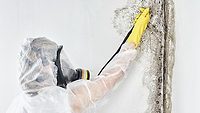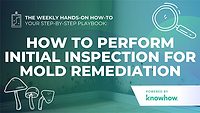One of the biggest challenges faced by people sick from mold is the fact that doctors, friends, and other family members dismiss their symptoms simply because they, personally, do not get sick when exposed to mold.
Many victims of mold sickness are labeled as hypochondriacs and are accused of not being sick at all.
This is tragic because many people that get sick have no control over their sickness because their bodies have a genetic pre-disposition to mold illness.
The purpose of this article is to explain why contractors, particularly mold remediation professionals, should know why some of their customers get sick from mold and other’s do not.
There is actually a scientific reason, and understanding of that science will not only help you serve your customers more effectively, but also increase sales by addressing the needs of mold sensitized individuals.
Lessons Learned From Interviews With Mold Sensitized Individuals
In 2015, Wonder Makers Environmental, a company based in Michigan, launched a new website with the mission of educating consumers, contractors, and health professionals on the health concerns caused by mold. The website’s goal is to be the ultimate resource of mold information and contains many articles written by the CEO, Michael Pinto.
Since launching the website, numerous mold sensitized individuals have been interviewed and many lessons can be learned from these interviews.
- In general, there is a lack of appreciation among the medical community of the impact mold can have on certain individuals.
- The symptoms from mold sickness are broad, leading to multiple misdiagnoses of patients by many doctors.
- It is quite common for mold sensitized individuals to seek help from multiple medical practitioners and still not get healthy.
- Eventually, the individual learns mold has been the cause of the sickness.
- Mold sensitized individuals frequently are forced to seek alternative shelters because traditional remediation approaches are not adequate to address their sensitivities, even assuming that the current standard of care is followed.
Anecdotal Data Versus Scientific Data On Mold Illness
For more than a decade, people have tried to use the courts to sue for compensation from sicknesses caused by mold. During the early stages of these legal battles, the court system tended to side with the defendants citing a lack of scientific evidence that mold actually makes people sick.
Despite the lack of scientific evidence, anecdotal data from thousands of contractors working with occupants of water-damaged buildings documented the health challenges many faced.
In the 1980s, the World Health Organization, coined the term “Sick Building Syndrome”, which people believed was caused by poor indoor air quality caused by water damage to the buildings.
According to Erik Johnson, a mold expert and survivor, it was not until the 1990s, that the World Health Organization, acknowledged “Sick Building Syndrome” could be caused by toxic mold.
The medical community is beginning to acknowledge the health impact that water-damaged buildings can have. This recognition was made very public in 2015 with the release of the MOLDY documentary which featured health professionals and people who have suffered mental and physical health issues after moving into moldy houses.
In a presentation at the PLR Expo in Toronto, Canada, in November, 2015, CEO of Wonder Makers Environmental, Michael Pinto presented “13 Future Trends in the Restoration Industry“ and has since also written an update to several of his points.
One of the most notable trends he cites is a “A Tighter Connection Between Medicine and Environment.”
Pinto cites new diagnosing techniques to identify an illness called Chronic Inflammatory Response Syndrome (CIRS), which legitimizes the tie between water-damaged buildings (WDB) and sickness. He also cited research that has identified a genetic component to this condition, a screening test (VCS), and most importantly, a treatment regimen.
Pinto also believed the Environmental Relative Moldiness Index (ERMI) demonstrates the important ties between medicine and the environment. ERMI is a scientific test that analyzes dust samples for 36 mold species. This test provides base information to identify CIRS because 26 of the mold species are considered to be water damage indicators.
This test is important because one sample can be analyzed to identify the extent of water damage in the building that could make someone susceptible to CIRS sick. Importantly, this test provides an ERMI score, i.e. a HERTSMI-2 score that can be given to physicians and will help them assess whether a building will make their patient sick.
Because of growing medical awareness and the fact that there are now medical tests and drugs to diagnose and treat mold illness, Pinto believes one of the other outcomes of this acknowledgement will be a more active justice system where plaintiffs will now be able to get compensation because they now have science to back up their claims.
25% of the Population is Susceptible to Mold Illness
The most interesting aspect of the research on the effect that Sick Building Syndrome has on patients pertains to genetics.
One of the biggest problems with mold sickness is that it impacts everyone differently.
Some may experience minor allergies, and other health conditions like asthma and chronic sinusitis, while other mold sensitized patients may suffer severe illnesses.
One physician documented the health symptoms of 227 patients who lived in water-damaged buildings during a three year period and found 98% of his patients had one of the gene types where their immune systems were not able to effectively deal with contaminants from water-damaged buildings.
As stated by Pinto:
“In layman’s terms, two different genes have been isolated, which keep some people’s immune systems from functioning properly when they have been exposed to contaminants from water-damaged buildings. Instead of properly identifying and eliminating the foreign invader, those body defense mechanisms increase the problem. When viewed with a basic understanding of genetic distributions, this research made it clear that up to a quarter of the population (25%) is at increased risk from exposure to water-damaged buildings.”
This research is very significant because it demonstrates that up to 25% of the population has a genetic pre-disposition that makes them more susceptible to mold illness and the condition known as Chronic Inflammatory Response Syndrome (CIRS).
Because of this research, the scientific community and legal system is now taking much greater notice because diagnostic tests, lab tests and treatment tools are being developed to help these patients. In short, the data is no longer anecdotal, but based on objective measures.
What Is Chronic Inflammatory Response Syndrome (CIRS)?
According to Dr. Ritchie Shoemaker, CIRS is:
“An acute and chronic, systemic inflammatory response syndrome acquired following exposure to the interior environment of a water-damaged building with resident toxigenic organisms, including, but not limited to fungi, bacteria, actinomycetes and mycobacteria as well as inflammagens such as endotoxins, beta glucans, hemolysins, proteinases, mannans, c-type lectins and possibly spirocyclic drimanes, plus volatile organic compounds.”
Listed below are the 37 symptoms associated with CIRS.
1. Fatigue
2. Weakness
3. Aches
4. Muscle Cramps
5. Unusual Pain
6. Ice Pick Pain
7. Headache
8. Light Sensitivity
9. Red Eyes
10. Blurred Vision
11. Tearing
12. Sinus Problems
13. Cough
14. Shortness of Breath
15. Abdominal Pain
16. Diarrhea
17. Joint Pain
18. Morning Stiffness
19. Memory Issues
20. Focus/Concentration Issues
21. Word Recollection Issues
22. Decreased Learning of New Knowledge
23. Confusion
24. Disorientation
25. Skin Sensitivity
26. Mood Swings
27. Appetite Swings
28. Sweats (especially night sweats)
29. Temperature Regulation or Dysregulation Problems
30. Excessive Thirst
31. Increased Urination
32. Static Shocks
33. Numbness
34. Tingling
35. Vertigo
36. Metallic Taste
37. Tremors
For 75% of the population, when exposed to biotoxins caused by mold, the individuals’ immune system responds by binding with the invading poison that allows its cells to filter the biotoxins through the liver, kidneys, and other organs.
In contrast, 25% of the population who have the genetic susceptibility to mold illness get sick because their body’s immune system does not bind to the biotoxin, meaning it is not eliminated and therefore continues to circulate, causing the many symptoms, documented above.
The “C” in CIRS refers to the term “Chronic” because individuals exposed to poisons from mold are unable to eliminate the toxins from their body, resulting in on-going and escalating sickness, particularly if the person is continually exposed to mold. This is the primary reason that the first priority of medical practitioners treating mold sensitized patients is to begin the detox process which also must coincide with movement away from the building that is constantly exposing the person to the toxins.
The “I” in CIRS refers to the term “Inflammatory” because the constant exposure to the toxins creates a cycle of sickness, meaning the individual’s immune system is constantly trying to fight the toxins, leading to inflammation.
The “R” in CIRS refers to “Response” because the human body is designed to respond to invading toxins. In the case of patients suffering from mold sickness, the immune system is constantly trying to fight the toxins causing a stress on the complete immune system of the individual, which in turn leads to other health conditions.
As stated by Pinto, the “S” in CIRS refers to “Syndrome” because:
“The symptoms are a result of many factors, including external exposures and internal responses. The contaminants from water-damaged buildings should trigger the activation of an immune response, but some people’s genetic structure does not allow the proper recognition of the biotoxin. Since this combination of circumstances inhibits the clearance of the poison from the body, these harmful substances continue to circulate and create continual damage. With such individuals there is no linear dose/response relationship, meaning that even trivial exposures can create severe problems.”
Is CIRS Life Threatening?
The major problem that individuals with CIRS face is their bodies immune systems become severely compromised and weakened from the vicious cycle of invading poison, immune response, and inflammation.
The end result is many of their bodies systems are damaged, leading to a wide range of health conditions, some life threatening.
For this reason, many mold survivors have reported that they have abandoned the primary residence that initially made them sick; instead, seeking shelter wherever they can find it, especially very dry areas, with dessert like conditions where moisture is limited. These drastic measures were taken by these individuals because their bodies have become so sensitized to mold that even minor exposure triggers severe reactions.
Fortunately, the continued research on mold sickness is creating hope because treatments been have developed that help individuals detox and eliminate the poisons, followed by rebuilding the immune system so that it regains strength.
How Can This Knowledge Help Your Business?
At PLR Expo in 2015, Michael Pinto asked the audience of about 400 contractors if they had heard of Chronic Inflammatory Response Syndrome? Very few raised their hand. Honestly, I was a bit surprised. Keep in mind, one of the trends that Pinto identified was “Growing Public Awareness.” If consumers are getting more educated, you should also.
One of the goals of this article is to explain why some of your customers are sick from mold and others are not. Now you know the answer: 25% of the population has a genetic pre-disposition to mold illness and may suffer from CIRS.
Learn about CIRS and know the symptoms. In fact, when you meet with a prospective client who has health issues that could possibly be caused by mold, ask them how many of the 37 symptoms of CIRS they have.
If you suspect they have CIRS, ask them to consult with a physician who can verify the diagnosis and prescribe a treatment plan.
The next step is to work with your customer to properly remediate their home. It is no longer just a matter of dealing with mold in just one part of the home when you are dealing with a mold sensitized customer. You need to understand the big picture, meaning you need to work on a plan that addresses spore deposition throughout the home and also understand that the HVAC system could also be contaminated.
Addressing The Needs Of Mold Sensitized Individuals Will Increase Your Bottom Line
Recently, one of my clients began working on a mold project that was referred to them by Wonder Makers Environmental. The mold sensitized homeowner was no longer living in her home because her health kept getting worse as she suffered from CIRS and was advised to move out until her home was properly remediated.
Wonder Makers referred this homeowner to a contractor who understood how to deal with mold sensitized individuals. The mold remediator’s work plan addressed the source of contamination, i.e. the moisture source. Once this problem was fixed, the scope of work addressed the areas of the home that had mold growth. The work plan had three goals:
- Use proper standard of care, containment, negative air, air scrubbers, etc. to remove porous mold contaminated content. The contractor also implemented their mold prevention system backing it up with a 25 year guarantee.
- Create a work plan to address the spore contamination in the HVAC system by sub-contracting the clean up with a reputable firm
- Address the spore deposition in the home by setting up a clean room where contents could be cleaned with an effective solution, like Mold-B-Gone, and HEPA vacuumed could be stored. It should be noted, the use of chemicals to clean the contents is not necessary, though this contractor chose to use this chemical because the ingredients are all natural, EPA approved, and on the FDA Gras list.
The total price tag for this project was more than $20,000.
The customer is happy because the fungal ecology of her home is at normal levels and she can live in her home again.
How many customers can you help if you simply ask the right questions?
How might your business grow if you position it as the expert on CIRS and begin educating consumers?
How many jobs will you win from competitors if your education efforts build more trust with customers?
Bottom line, there is a need for contractors that understand the needs of individuals adversely affected by mold. The science of mold is advancing. The fact that up to 25% of the population could be genetically pre-disposed to mold illness, means that contractors that want to grow their businesses exponentially should begin preparing themselves to service this market demand. How prepared are you?







